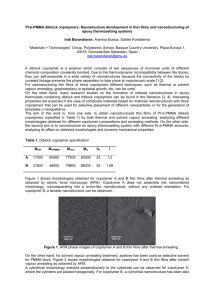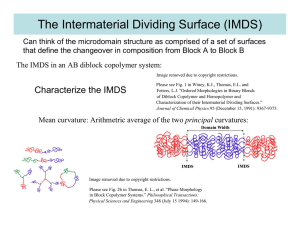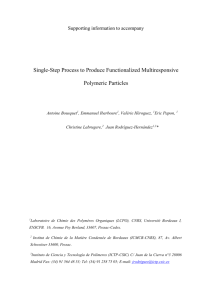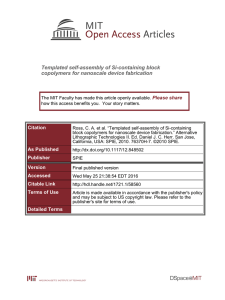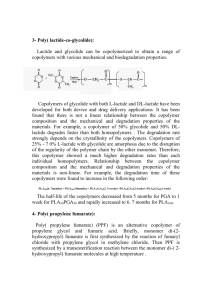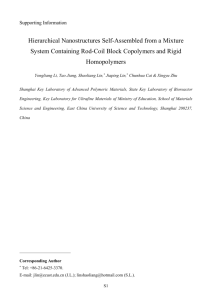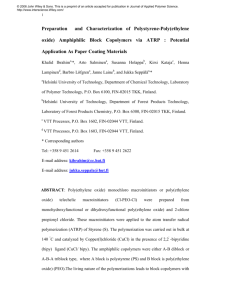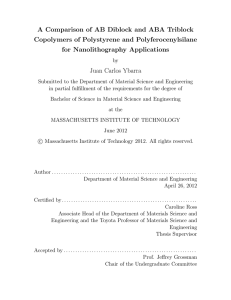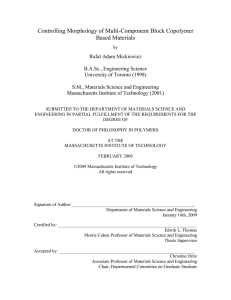solvent properties
advertisement
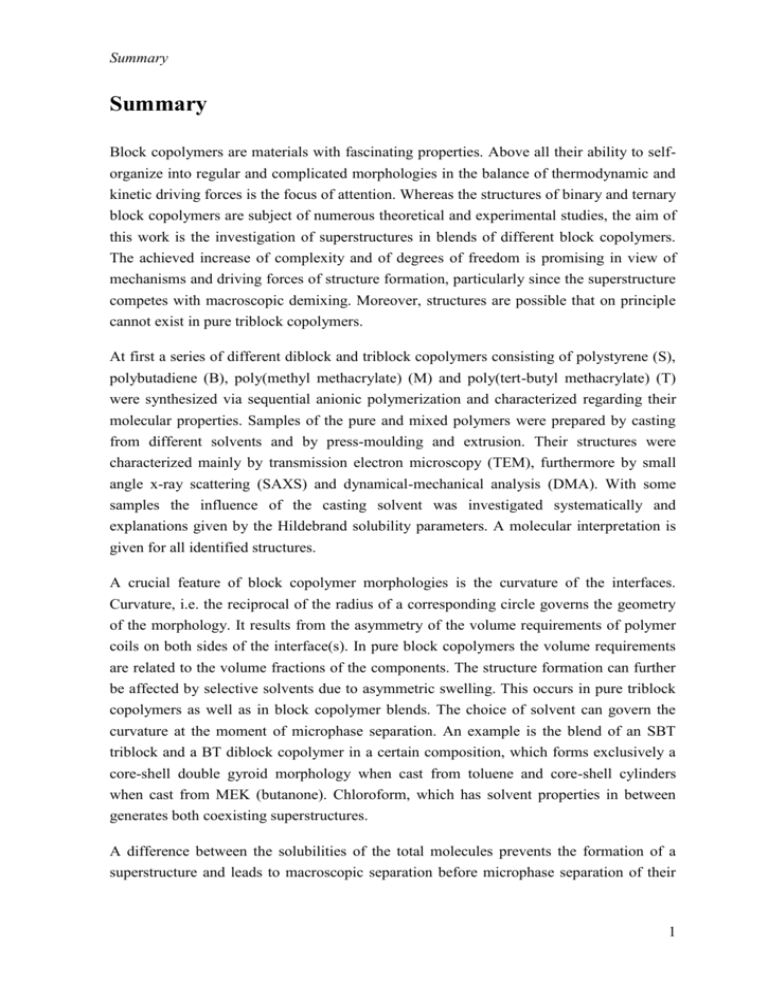
Summary Summary Block copolymers are materials with fascinating properties. Above all their ability to selforganize into regular and complicated morphologies in the balance of thermodynamic and kinetic driving forces is the focus of attention. Whereas the structures of binary and ternary block copolymers are subject of numerous theoretical and experimental studies, the aim of this work is the investigation of superstructures in blends of different block copolymers. The achieved increase of complexity and of degrees of freedom is promising in view of mechanisms and driving forces of structure formation, particularly since the superstructure competes with macroscopic demixing. Moreover, structures are possible that on principle cannot exist in pure triblock copolymers. At first a series of different diblock and triblock copolymers consisting of polystyrene (S), polybutadiene (B), poly(methyl methacrylate) (M) and poly(tert-butyl methacrylate) (T) were synthesized via sequential anionic polymerization and characterized regarding their molecular properties. Samples of the pure and mixed polymers were prepared by casting from different solvents and by press-moulding and extrusion. Their structures were characterized mainly by transmission electron microscopy (TEM), furthermore by small angle x-ray scattering (SAXS) and dynamical-mechanical analysis (DMA). With some samples the influence of the casting solvent was investigated systematically and explanations given by the Hildebrand solubility parameters. A molecular interpretation is given for all identified structures. A crucial feature of block copolymer morphologies is the curvature of the interfaces. Curvature, i.e. the reciprocal of the radius of a corresponding circle governs the geometry of the morphology. It results from the asymmetry of the volume requirements of polymer coils on both sides of the interface(s). In pure block copolymers the volume requirements are related to the volume fractions of the components. The structure formation can further be affected by selective solvents due to asymmetric swelling. This occurs in pure triblock copolymers as well as in block copolymer blends. The choice of solvent can govern the curvature at the moment of microphase separation. An example is the blend of an SBT triblock and a BT diblock copolymer in a certain composition, which forms exclusively a core-shell double gyroid morphology when cast from toluene and core-shell cylinders when cast from MEK (butanone). Chloroform, which has solvent properties in between generates both coexisting superstructures. A difference between the solubilities of the total molecules prevents the formation of a superstructure and leads to macroscopic separation before microphase separation of their 1 Zusammenfassung blocks. This is the case in nearly all combinations of different diblock copolymers (AB + AC). If two or more interfaces are present, the asymmetry of volume requirement of the polymer chains can be caused by different interfacial tensions. For example a pure symmetrically composed BSM triblock copolymer shows a core-shell double gyroid structure, where the interfaces are bent towards the core domains of B phase. This structure was identified by simulation of TEM projections. Asymmetry between the two interfaces in a ternary system can be realized by the asymmetry between the number of polymer chains. This is possible in mixtures of two block copolymers, which contain similar parts in their block sequences like ABC + AB. A and B blocks can mix in common phases whereby the volume requirement at the A-B interface becomes larger than at the B-C interface. Both interfaces curve and form socalled core-shell structures, where the core domains of C phase are covered by B shells that are embedded in an A matrix. By variation of the composition the corresponding core-shell structures of all known binary block copolymer morphologies could be found. For example the curvature of the core-shell double gyroid of the pure BSM triblock copolymer mentioned above caused by asymmetric interfacial tensions was compensated by addition of a BS diblock copolymer. First of all a lamellar structure results. On further increase of the BS content the curvature now bends towards the other direction and the original double gyroid is inverted. The B phase no longer forms the two core lattices but the matrix of the double gyroid superstructure surrounding the S shells with their M cores inside. Besides the mixing ratio the composition the polymers themselves affects the curvature. This is the case in a mixture of a symmetric SBM triblock copolymer and an asymmetric SB diblock copolymer containing more S. The resulting superstructure consists of M cylinders surrounded by four smaller and thus stronger curved B cylinders instead of a closed B shell. In this blend the interfacial tensions plays a part as well. Because a pure SBM triblock copolymer with the same overall composition shows a different morphology, the described structure can be attributed to the mixing effects mentioned above. The essential feature of these structures for the energetical explanation of ABC + ABblends is the existence of two different types of B chains. One type bridges the B domains from one interface to the other (triblock chains), the other type has free chain ends (diblock chains). The free energy of such mixed B domains has been calculated by Birshtein et al. and was often found to be lower than the reference state of both pure domains (macroscopical demixing). The mixing entropy of both chain types is discussed as the driving force for the superstructure formation. 2 Summary In a blend of two SBM triblock copolymers which differ only by the length of their middle blocks all three types of polymer blocks can form common phases. The junction points between the blocks arrange on common interfaces and therefore the interfaces bear equal chain numbers. At a certain composition the "knitting pattern" morphology is formed as a superstucture. Herein the B domains are cylinders with oval cross-section which enables the long and short B chains to build up their favored curvature. In a blend of an SBM and a BSM triblock copolymer the structure formation is more complicated due to the different connectivity of the blocks. According to the composition layer structures with different sequences, wavy lamellae or alternating arrangements of layers and cylinders were observed. This can be interpreted as a combination of different driving forces like asymmetrical interfacial tensions and chain numbers per interface. The SBM + BSM situation is distantly related to the blend SBT + BSM except for the incompatibility of T and M. Hence these phases form the single gyroid lattices of a double gyroid morphology. They are covered by a shell of B in the case of T and by a shell of S in the case of M. These two shells touch each other at a third gyroid surface. It is larger than the other two interfaces because it bears twice the number of chains. Lamellar superstructures without curvature are possible, if the junction points are separated on different interfaces. In a mixture of an SBT triblock and an ST diblock copolymer the S and T chains of both polymers are mixed in S and T layers, respectively. The chains of one polymer are tethered at one interface, the others at the opposite interface. Due to the different interfacial tension of both interfaces, the chain stretching is different. Therefore the interpenetration is asymmetric, which causes an entropic gain according to calculations of Leibler, Erukhimovich et al. Since this is the case in all S and T lamellae, a polar or noncentrosymmetric sequence "... SBT TS SBT TS ..." is formed. In general the superstructures of all blends were found to be of a determined composition. If the overall composition of the blend differs from that, the excess polymer is separated in its pure morphology. Often more than one superstructure exist for a given polymer combination. If the blend composition is in between, both superstructures coexist in the blend sample. Moreover kinetic effects like different growth rates or selective swelling with the solvent often influence the formation of a structure. The investigation of mixtures of different block copolymers reveals besides new ways to well-known structures a variety of new morphologies and broadens the understanding of their structure formation by systematic variation of different parameters. It represents a consistent development in the ongoing research on block copolymers and their properties. 3
